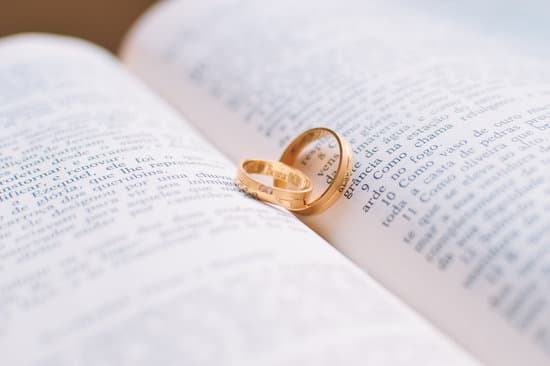A Jewish wedding is a beautiful and elaborate ceremony that is steeped in tradition and rich with meaning. From pre-wedding festivities to post-wedding celebrations, every aspect of a Jewish wedding is infused with ancient customs and rituals that have been passed down through generations.
One of the most intriguing aspects of a Jewish wedding is the length of the celebration, which often spans several days. In this article, we will explore the various traditions and customs that make up a Jewish wedding, as well as delve into the significance of the multi-day celebration.
The traditions surrounding a Jewish wedding date back thousands of years and continue to be an integral part of the lives of Jewish couples today. From the engagement period to the post-wedding celebrations, each phase of the wedding process is marked by unique customs that serve to honor the sacred union between bride and groom.
For many couples, understanding these traditions not only adds depth and meaning to their wedding experience, but also connects them to their cultural heritage in a profound way.
In this comprehensive guide, we will take an in-depth look at each stage of a traditional Jewish wedding, including pre-wedding festivities such as engagement parties and Tenoim ceremonies, as well as the significant rituals that take place during the wedding ceremony itself. We will also explore the festive elements of a Jewish wedding reception, including traditional dances and special blessings.
Additionally, we will examine the deeper significance behind the seven-day celebration that follows a Jewish wedding, shedding light on its spiritual and symbolic meaning. Whether you are planning your own Jewish wedding or simply want to gain insight into this time-honored tradition, this article aims to provide valuable insights into the timeless beauty of a Jewish marriage celebration.
Pre-Wedding Festivities
Jewish weddings are steeped in tradition, and the pre-wedding festivities are no exception. These events are not just a celebration of the impending nuptials but also hold deep cultural and religious significance for the couple and their families.
Engagement
In Jewish tradition, the engagement period is a time of joy and anticipation. After the couple has made the decision to marry, they may choose to exchange rings as a symbolic gesture of their commitment to each other. This is often followed by a small gathering of family and friends to mark the beginning of this exciting journey towards marriage.
Vort
The Vort, or engagement party, is an important pre-wedding event where both families come together to celebrate the upcoming union of their loved ones. It is a time for everyone to get acquainted with each other and establish bonds before the wedding day. The atmosphere at a Vort is typically joyous and lighthearted as guests share in the happiness of the engaged couple.
Tenoim
The Tenoim ceremony symbolizes the formal agreement between both families for the union of the couple. Traditionally, representatives from each side break a plate as a demonstration that once broken, it cannot be fully repaired – much like an engagement broken off if not taken seriously. This serves as an acknowledgement of the seriousness of marriage within Jewish tradition.
These pre-wedding festivities serve as a precursor to several days of celebrations leading up to and following the actual wedding ceremony. It’s all part of building up excitement for one of life’s most significant milestones – bringing two people together in marriage before their community and under God’s blessing.
The Wedding Ceremony
The Jewish wedding ceremony is a beautiful and sacred event that is filled with meaningful traditions and rituals. From the signing of the Ketubah to the recitation of the Seven Blessings, each element holds deep significance for the couple and their families. In this section, we will explore the various components of the wedding ceremony and delve into their importance in Jewish tradition.
Ketubah: The Marriage Contract
One of the central elements of a Jewish wedding ceremony is the Ketubah, a marriage contract outlining the rights and responsibilities of the groom towards his bride. This document holds immense sentimental value and is often adorned with intricate designs and calligraphy. The Ketubah is signed by two witnesses before being presented to the bride during the wedding ceremony.
Bedeken: Veiling of the Bride
In the Bedeken ritual, the groom approaches his bride to lower her veil before they are officially married. This custom dates back to biblical times and symbolizes modesty, humility, and respect for one another. The veiling also serves as a reminder of the story of Jacob marrying Leah instead of Rachel due to a similar veil covering her face.
Chuppah: Symbolizing New Home
The Chuppah, or wedding canopy, represents a new home being built by bringing together two individuals in marriage. Underneath this symbolic structure, the couple stands together as they exchange vows and declarations of love. The open sides of the Chuppah are said to invite divine blessings into their union while providing ample space for family and friends to witness their commitment to each other.
Overall, each aspect of the Jewish wedding ceremony holds special meaning, serving as a source of joy and spirituality for all involved. This tradition has been preserved throughout generations, representing continuity and endurance within Jewish culture.
Traditional Jewish Wedding Customs and Rituals
A Jewish wedding is rich in traditions and customs that have been practiced for centuries. These customs are an integral part of the wedding ceremony and are meant to symbolize the couple’s commitment, faith, and love for each other. Here are some traditional Jewish wedding customs and rituals:
- Bedeken: This is the veiling of the bride by the groom, which takes place in a private room before the ceremony. The groom approaches the bride and places the veil over her face, symbolizing his love for her inner beauty.
- Ketubah: The ketubah is a written marriage contract outlining the groom’s responsibilities to the bride. It is signed by witnesses and displayed during the wedding ceremony as a symbol of their commitment to each other.
- Chuppah: The chuppah is a canopy under which the couple stands during the wedding ceremony. It symbolizes their new home together and their future life as a married couple.
- Seven Blessings: During the ceremony, seven blessings are recited over wine, symbolizing joy and celebration. These blessings are meant to acknowledge God’s creation, joy, love, peace, companionship, and more.
These are just a few examples of the many beautiful customs and rituals that take place during a traditional Jewish wedding. Each one holds deep meaning and significance for the couple as they embark on this new chapter in their lives.
The Wedding Reception
After the traditional Jewish wedding ceremony, the celebration continues with the wedding reception. One of the key elements of this celebration is the Seudat Mitzvah, a festive meal that fulfills the mitzvah (religious commandment) of celebrating and rejoicing with the newlywed couple. This meal typically includes traditional Jewish dishes and is a time for family and friends to come together and share in the joy of the newly married couple.
Another highlight of the wedding reception is the Hora dance, where guests form a circle and dance to lively Jewish music. The bride and groom are lifted on chairs as part of this energetic and joyful dance, symbolizing their elevation into their new life together. The Hora dance is a fun and lively tradition that adds to the celebratory atmosphere of the reception.
During the wedding reception, it is also customary to recite the Sheva Brachot, or seven blessings. These blessings are an integral part of Jewish wedding tradition and are recited over a cup of wine. The Sheva Brachot invoke blessings for joy, love, harmony, companionship, peace, happiness, and contentment for the newly married couple as they commence their life together.
| Element | Description |
|---|---|
| Seudat Mitzvah | A festive meal fulfilling religious commandment to celebrate with newlyweds |
| Hora Dance | Lively circle dance with bride and groom lifted on chairs |
| Sheva Brachot | Seven blessings recited over a cup of wine for newly married couple |
Post-Wedding Celebrations
After the wedding ceremony and reception, the festivities continue with the post-wedding celebrations in a Jewish wedding. The Sheva Brachot, Yichud, and Tisch are all important customs that hold significance in the tradition.
The Sheva Brachot, also known as the “Seven Blessings,” is a series of blessings that are recited during the wedding meal and continued at subsequent meals for seven days following the wedding. These blessings celebrate the couple’s union and are meant to bring joy and festivity to the newlyweds.
Following the Sheva Brachot, the couple participates in Yichud, which translates to “seclusion.” This is a private moment for the newly married couple to spend together immediately after their wedding ceremony. It symbolizes their new bond as husband and wife before joining their guests at the reception.
Lastly, the Tisch is a traditional pre-wedding celebration typically held for Hasidic Jews. During this event, the groom sits at a table surrounded by his male guests while they sing and offer words of Torah wisdom. The groom’s female guests hold a similar celebration called Kabbalat Panim. These pre-wedding events serve as an opportunity for spiritual reflection and celebration before the wedding ceremony takes place.
These post-wedding celebrations play an important role in extending and solidifying the joyful atmosphere surrounding a Jewish wedding. They help to create lasting memories for both the newlyweds and their guests while honoring timeless traditions.
The Meaning and Significance of the Seven-Day Celebration
In Jewish tradition, a wedding is not just a one-day event, but rather a week-long celebration. This seven-day period holds great meaning and significance in the lives of the newly married couple and their families. The celebration begins with the wedding ceremony and is followed by a series of post-wedding rituals, each serving a unique purpose in the continuation of the marriage.
One of the central elements of this extended celebration is known as Sheva Brachot, which translates to “Seven Blessings.” During the seven days following the wedding, the newlyweds are honored with special meals called Seudat Mitzvah where these blessings are recited. These meals are hosted by different family members or friends each day, symbolizing the support and love from their community as they start their new life together.
Yichud, another key component of the seven-day celebration, takes place immediately after the wedding ceremony. It involves a private seclusion for the bride and groom to spend some intimate time alone together. This serves as an opportunity for them to reflect on their union and begin building their life as a married couple.
The seven-day celebration plays an important role in solidifying the bond between not only the newlyweds but also between both families who come together to celebrate this joyous occasion. It creates a sense of unity, support, and love that will continue to sustain and strengthen the marriage throughout its lifetime.
| Element | Description |
|---|---|
| Sheva Brachot | The Seven Blessings recited during special meals hosted for the newlyweds |
| Yichud | A private seclusion for the bride and groom immediately after the wedding ceremony |
Modern Interpretations and Adaptations of Jewish Wedding Traditions
In contemporary times, many Jewish couples have been finding ways to adapt and modernize traditional wedding customs while still honoring the essence and significance of these age-old traditions. One modern interpretation is the inclusion of both partners in the signing of the ketubah, a marriage contract that outlines the couple’s commitment to each other. This reflects a more egalitarian approach to marriage, emphasizing the importance of equality and mutual respect within the relationship.
Another adaptation that has become increasingly popular is the customization of the seven blessings, known as Sheva Brachot, recited during the wedding ceremony. Couples have been incorporating personalized blessings or having family members or close friends deliver meaningful words of wisdom and well-wishes to add a personal touch to this sacred ritual.
Additionally, there has been a shift towards more inclusive practices within Jewish wedding ceremonies, welcoming LGBTQ+ couples and accommodating interfaith marriages. Many rabbis and officiants are now open to officiating at weddings that may not fit into traditional norms, embracing diversity and ensuring that all couples can partake in these beautiful traditions regardless of their backgrounds.
Overall, these adaptations demonstrate how Jewish wedding traditions continue to evolve with time while maintaining their core values of love, commitment, and community. Couples are finding ways to infuse their own personalities and beliefs into these longstanding customs, creating meaningful and memorable experiences for themselves and their loved ones. With each generation comes new interpretations that honor tradition while reflecting the ever-changing landscape of love and marriage in today’s world.
- Inclusion of both partners in signing the ketubah
- Customization of the seven blessings (Sheva Brachot)
- Welcoming LGBTQ+ couples and accommodating interfaith marriages
Conclusion
In conclusion, the timeless traditions of a Jewish wedding are deeply rooted in history and hold significant meaning for those who participate in them. From the pre-wedding festivities such as the engagement, vort, and tenoim, to the wedding ceremony itself with its customs like the ketubah, bedeken, chuppah, and seven blessings, to the post-wedding celebrations including the sheva brachot, yichud, and tisch, each aspect of a Jewish wedding is rich with symbolism and tradition.
One of the most intriguing aspects of a Jewish wedding is the seven-day celebration that follows the ceremony. This period includes celebratory meals known as seudat mitzvah and sheva brachot, as well as special rituals such as yichud. This prolonged celebration highlights the importance of marriage in Jewish tradition and symbolizes the couple’s transition into their new life together.
Modern interpretations and adaptations of Jewish wedding traditions have allowed couples to personalize their ceremonies while still honoring their faith and heritage. Whether it’s incorporating elements from different cultural backgrounds or finding ways to make traditional customs feel more inclusive, contemporary Jewish weddings continue to evolve while maintaining their timeless significance. Ultimately, understanding these enduring traditions fosters a deeper appreciation for the beauty and meaning behind a Jewish wedding.
Frequently Asked Questions
How Long Does a Jewish Wedding Take?
A Jewish wedding can vary in length, but it typically lasts around 30 minutes to an hour for the ceremony itself. However, the entire celebration, including the reception, can last several hours, sometimes even all day and night.
What Days of the Week Do Jews Get Married?
In Judaism, weddings can take place on any day of the week except for Shabbat (sunset Friday to nightfall Saturday) and certain fast days or holidays. Sunday is a popular choice for Jewish weddings, but they can also happen on other days depending on personal or religious preferences.
What Religion Has the Longest Wedding Ceremony?
Hindu weddings are known for having one of the longest wedding ceremonies among religions. The rituals and traditions involved in a Hindu wedding can last for several days, with various ceremonies such as the Haldi, Mehendi, Sangeet, and the actual wedding ceremony itself taking place over this extended period of time.

I have been involved in marriages for over 20 years helping couples and singles understand more about them.



![How Many Days for RSVP Wedding RSVP by [date] for the wedding: How many days do I have to RSVP for the wedding](https://www.marriagespirit.com/wp-content/uploads/2023/11/wedding-955-150x150.jpg)

